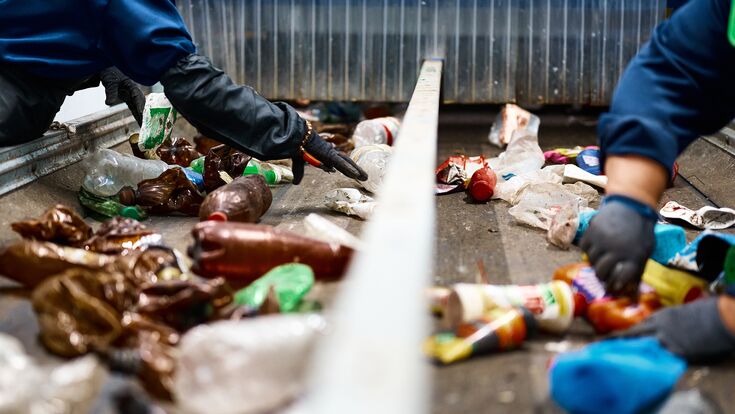National Safety Month : Workplace security: Better safe than sorry

Since 1996 June is the National Safety Month in the United States. The aim of Summer Safety Month is to raise public awareness of the key safety and health risks that increase during the summer months in order to reduce the number of injuries and deaths at home and at work. The waste management industry is notoriously high on the list of the most dangerous places to work. WMW talked with Nick Brown, Senior Director at Ansell, one of the world's leading providers of safety solutions and an end-to-end manufacturer of personal protective equipment for healthcare and industrial workplaces, about the hazards faced by waste management workers, how PPE has improved over the years and setting up safety protocols.
Can you describe your understanding of the key safety hazards in a waste management or recycling facility?
All incoming materials in a waste management or recycling facility have to be sorted and more often than not, it’s sorted by hand on a conveyor belt. This introduces risks such as unknown liquid, chemical, or oil contamination, potential combustion, and hazards like sharp objects, especially syringes.
Additionally, waste management and recycling requires extreme physical exertion which poses significant ergonomic risks including lifting and repetitive sorting tasks that strain the hands, wrists, and lower back. Facilities normally operate with numerous machines, such as constantly moving conveyor belts, alongside physical hazards like trucks and forklifts in motion. Workers need to be protected against trip or slip fall incidents as well as eye protection to safeguard against liquid spills/splashes. The noisy environment also highlights the need for hearing protection.
Related article: Getting waste collection off the list of the most dangerous jobs
What are the most common injuries in waste management facilities?
The most common injuries in waste management and recycling facilities include cuts, skin punctures, and needle stick injuries, due to handling sharp objects and syringes. Workers also often face chemical burns, skin conditions, and rashes from exposure to hazardous substances. Additionally, due to the physical demands of lifting and sorting materials as well as poor ergonomics, workers are at risk for sprains and strains as well as musculoskeletal disorders (MSDs). Dust and airborne contaminants also present respiratory risks and heat stress poses a common risk as well during the summer.
What types of personal protective equipment (PPE) are essential for people working there, and how to ensure they are used correctly?
Workers in waste management and recycling facilities require several types of essential personal protective equipment (PPE) to ensure safety. This includes cut-resistant gloves and puncture-resistant gloves that have sufficient dexterity that enable effective sorting and handling, along with cut-resistant sleeves for added protection. Chemical aprons are also essential to protect against hazardous chemicals and cooling vests to mitigate heat stress and risks during hot summers. Safety boots are also recommended. IoT devices are also essential to monitor worker movements, environmental conditions, and to avoid accidents involving forklifts and other powered industrial trucks (PITs). These technologies help enhance safety protocols and ensure protection measures.
Related article: SWANA highlights workplace dangers for solid waste collection workers

How have those improved over the last few years?
In recent years, advancements in personal protective equipment (PPE) for waste management and recycling facilities have significantly improved. PPE now offers higher levels of cut and chemical protection in single solutions by leveraging thinner yarns that can enhance comfort and dexterity for workers. This improves the overall worker experience and increases adoption rates while providing increased multi-hazard protection. Moreover, advancements in IoT (Internet of Things) and SaaS (Software as a Service) solutions provide more real time data for safety and operations managers to monitor risk and productivity more effectively in the processing site. This real-time monitoring enhances hazard avoidance strategies and facilitates process engineering for safer and more productive workplaces.
How can wearable devices protect workers from unseen risks and injuries?
Wearable devices play a crucial role in protecting workers from unseen risks and injuries in several ways. They can identify risky movements that can lead to long-term musculoskeletal disorders (MSDs), which were previously difficult to capture. MSDs pose the risk of limiting the career span for many frontline workers and drives an enormous on-cost for employers, healthcare facilities and insurers alike. Wearables also have the ability to monitor hazardous situations such as heat stress, lone worker incidents, chemical spills, and gas presence in real time, allowing for immediate responses. By providing continuous data, these devices enable more effective decision-making for long-term workplace processes and operations, engineering out risks and hazards to create safer work environments.
What would be the best way to set up safety protocols for a waste management facility?
The best way to set up safety protocols for a waste management or recycling facility starts with effective hazard observation and risk reporting. This can be enabled by working with expert consultants, introducing SaaS solutions into work practices to digitize safety assessment and reporting capabilities, and leveraging best-in-class risk identification and PPE recommendation platforms. Change management can be difficult but working with manufacturers of PPE in partnership to drive adoption, training and onboarding can go a long way to driving culture change and increased compliance in facilities. Implementing options such as signage, digitized worker prompts, and regular toolbox talks can help safety protocols. Additionally, conducting visual inspections of employees regularly ensures adherence to safety standards, while mandatory safety training for all employees, followed by signing off on their understanding, further strengthens safety measures within the facility.


